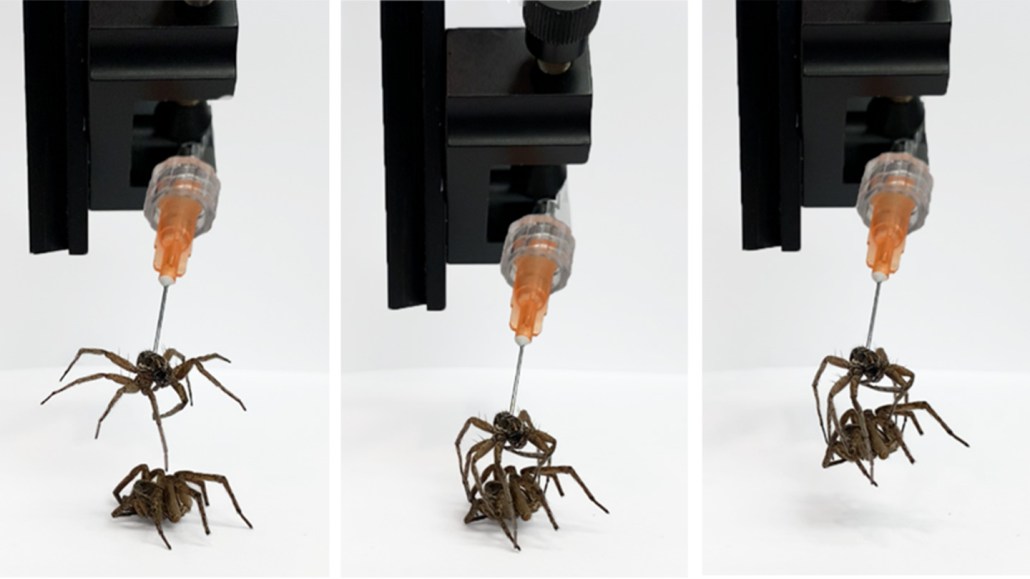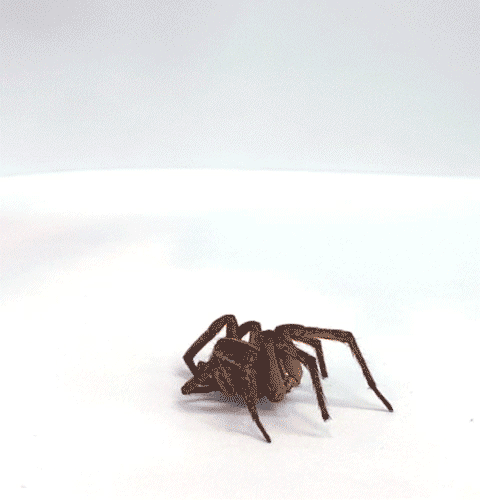Engineers put a dead spider to work — as a robot
Reanimating the dead is part of a new research field: necrobotics

Sticking a syringe into a dead wolf spider’s back turned it into a “necrobot” gripper. It proved strong enough to pick up a second spider corpse.
T.F. Yap and coauthors
Share this:
- Share via email (Opens in new window) Email
- Click to share on Facebook (Opens in new window) Facebook
- Click to share on X (Opens in new window) X
- Click to share on Pinterest (Opens in new window) Pinterest
- Click to share on Reddit (Opens in new window) Reddit
- Share to Google Classroom (Opens in new window) Google Classroom
- Click to print (Opens in new window) Print
By Asa Stahl
Engineers have literally reanimated dead spiders. Now those corpses do their bidding.
It’s part of a new field called “necrobotics.” Here, researchers converted the corpses of wolf spiders into grippers that can manipulate objects. All the team had to do was stab a syringe into a dead spider’s back and superglue it in place. Pushing fluid in and out of the cadaver made its legs open and shut.
It all started when Faye Yap saw a dead spider in her lab. Yap is a mechanical engineer at Rice University in Houston, Texas. She wondered: Why do spiders curl up when they die? The answer: Spiders are hydraulic machines. That means they move by pushing fluid around their bodies. For spiders, that fluid is blood. They extend their legs by forcing blood into them. A dead spider has no blood pressure. So, its legs curl up.

“We were just thinking that was so cool,” says Yap. She and her team wanted to use that ability somehow. And since they sometimes do research on grippers, they decided to try using a spider to make one.
They first tried gently warming the dead wolf spiders in a special kind of kitchen pan. They hoped the wet heat would make the spider expand and push its legs out. It didn’t. So the researchers injected fluid straight into the spider’s corpse. And just like that, they could control the spider’s grip. They could use the dead spider to pull wires from a circuit board — or even pick up other dead spiders. Only after hundreds of uses did the necrobots start to become dehydrated and show signs of wear.
Yap’s group described this corpse-tech July 25 in Advanced Science.
In the future, the team will coat the spider bodies with a sealant in hopes those bodies will last even longer. But the next big step, Yap says, will be to figure out more about how spiders work so they can control each of the legs individually. Her team hopes their findings could translate into ideas to better design more conventional (non-corpse) robots.
“That would be very, very interesting,” says Rashid Bashir. He’s a bioengineer at the University of Illinois Urbana-Champaign who did not take part in the new research. A spider corpse itself probably would not make an ideal robot, he says. Unlike “hard robots,” he suspects, it won’t perform consistently — and its body will break down over time. But engineers can definitely take lessons from spiders. “There’s a lot to be learned from biology and nature,” Bashir says.
Yap is no mad scientist, despite the whole reanimating dead spiders thing. She wonders whether it’s OK to play Frankenstein, even with spiders. When it comes to this type of research, she says, no one really talks about what’s moral — as in what’s right or wrong.
Bashir agrees. He says scientists need to figure out the morality of this sort of bioengineering before they get too good at it. Otherwise, he asks, “how far do you go?”







